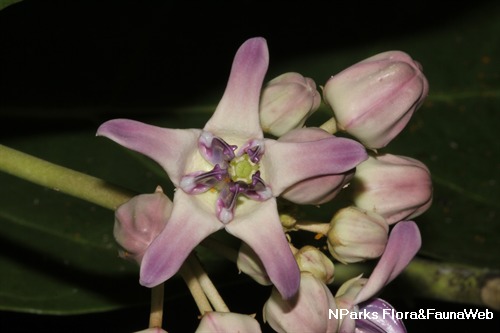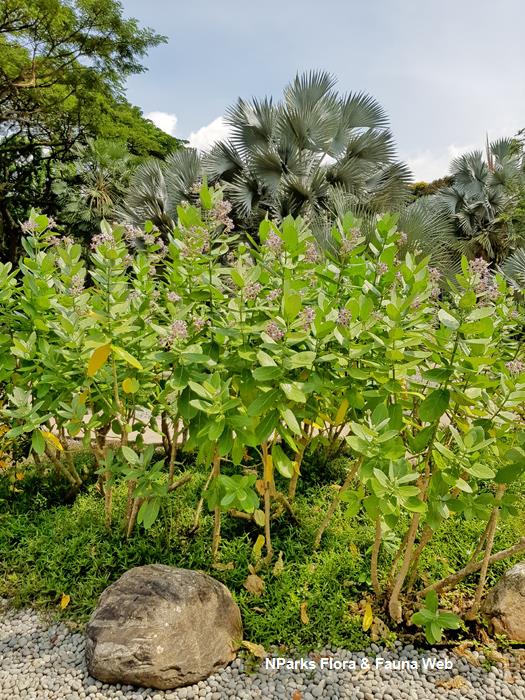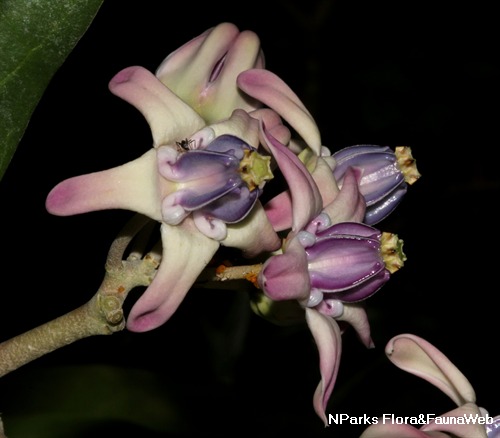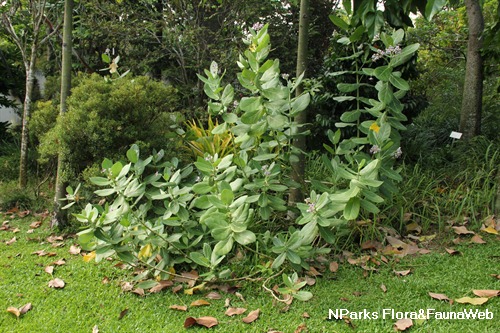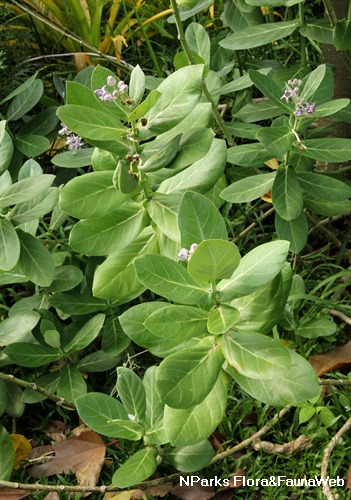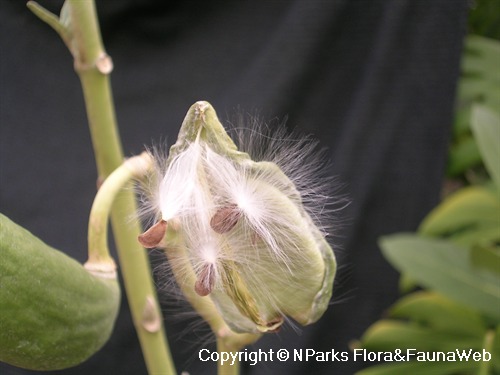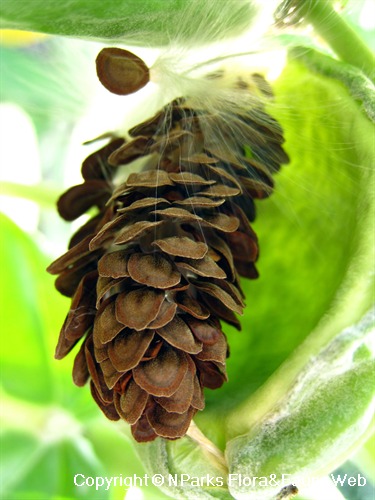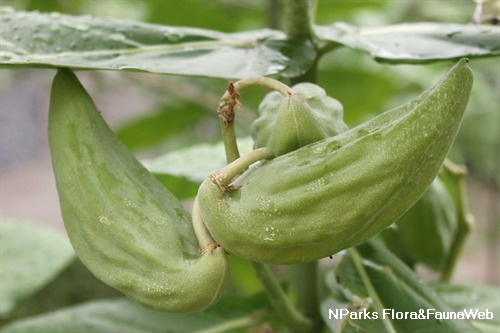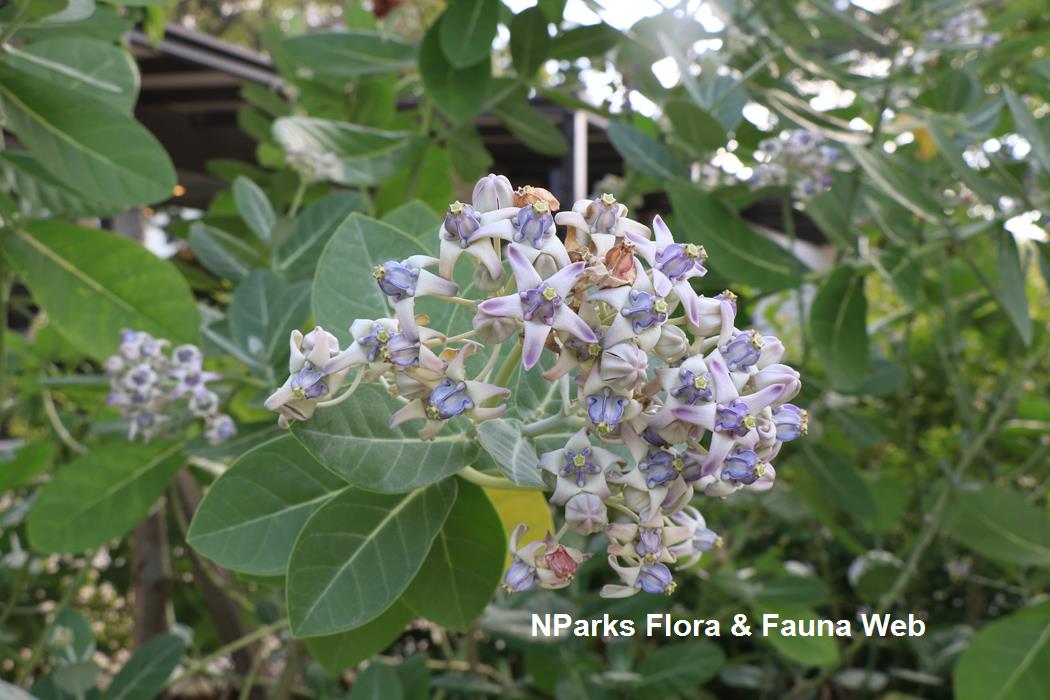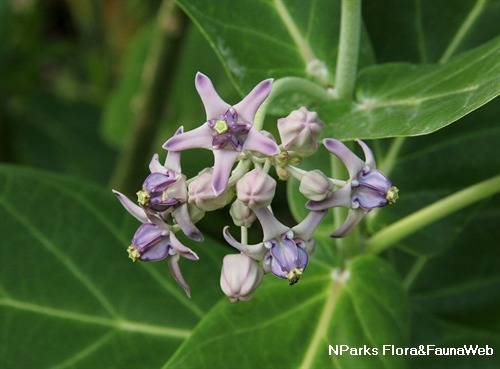
Back
Calotropis gigantea (L.) W.T.Aiton
| Family Name: | Apocynaceae |
| Synonyms: | Asclepias gigantea |
| Common Name: | Crown Flower, Remiga, Merigu, Giant Indian Milkweed, Giant Milkweed, Ivory Plant, Swallow-wort, Asclepiad Tree, Kayu Berduri, Kemengu, Rembaga, 牛角瓜, 大皇冠花 |
Name
Classifications and Characteristics
| Plant Division | Angiosperms (Flowering Seed Plants) (Dicotyledon) |
|---|---|
| Plant Growth Form | Shrub |
| Lifespan (in Singapore) | Perennial |
| Mode of Nutrition | Autotrophic |
| Maximum Height | 1.2 m to 4 m |
| Maximum Plant Spread / Crown Width | 1.8 m to 2.5 m |
Biogeography
| Native Distribution | India, Bangladesh, Nepal, Sri Lanka, Laccadive Islands, Maldives, East Himalaya, South-Central and Southeastern China, Hainan, Cambodia, Laos, Vietnam, Thailand, Peninsular Malaysia, Sulawesi. |
|---|---|
| Preferred Climate Zone | Tropical, Sub-Tropical / Monsoonal, Desert / Arid |
Description and Ethnobotany
| Growth Form | Medium to big shrub with stout rangey form, up to 4m height when planted in ground. |
|---|---|
| Foliage | Leaves large, thick, tomentose-velvety, pale silvery-green with powdery bloom on both surfaces. |
| Fruit | Fleshy capsules, curved and somewhat horned-shaped, ripening from green to yellowish-brown, and splitting apart to reveal small lightweight seeds with fine woolly hairs which assist in dispersal by wind. |
| Habitat | Naturally distributed in areas ranging from dry woods and stream banks to roadsides. |
| Associated Fauna | Host plant for butterflies like Danaus chrysippus (Plain Tiger) and Euploea core (Common Crow) -- caterpillars that feed on its sap-rich leaves are unpalatable to predators. Flower nectar attracts Xylocopa species (Carpenter Bees). Tufted seeds used as nest-lining by sunbirds. Also host for Aphis nerii (Yellow Aphid) colonies, which feed on the sap and breed on the plant. |
| Cultivation | Tolerates drought and saline sites. Allow soil to dry out before watering. Give space for plant to grow. Propagate by seeds or cuttings. Member of milkweed family -- when damaged or cut, all parts of plant exude milky sap, which may cause skin irritiation in sensitive individuals. Sap is toxic to mammals, and causes vomitting and intestinal irritation when ingested. Known to have caused poisoning in grazing cattle. |
| Etymology | Genus epithet 'Calotropis' means 'beautiful' (kalos) and 'ship keel' (tropis) in Greek, a reference to the ridged coronal scales on the flowers. Species epithet 'gigantea' means 'large', probably alluding to the size of the plant and its flowers. |
| Ethnobotanical Uses | Edible Plant Parts : Edible Flowers Food (Herb or Spice) Others: Medicinal: All parts of plants considered to be medicinally effective if taken in small doses. Bark used for dermatitis and syphilis -- treatment is so effective for the latter that plant is known as 'vegetable mercury'. Leaves used as poultice. Flowers used to relieve asthma. Toxic milky sap also known to be used to induce abortions and for infanticide. Products: Plant sap used for tanning and making yellow dye. Fine fibres can be extracted from stems. Flowers are long-lasting, and often used as cut flower in floral arrangements in Thailand. Flowers also strung into leis in Hawaii. |
Landscaping Features
| Desirable Plant Features | Ornamental Flowers, Ornamental Foliage |
|---|---|
| Landscape Uses | Coastal, General, Flowerbed / Border, Beachfront / Shoreline |
| Thematic Landscaping | Silver Garden, Butterfly Garden, Naturalistic Garden |
| Usage Hazard - Cons | Irritant - Sap, Toxic Upon Ingestion |
| Usage Hazard - Cons Remarks | When injested, milky sap causes vomitting and intestinal irritation in mammals. Known cases of poisoning in cattle. |
Fauna, Pollination and Dispersal
| Fauna Pollination Dispersal Associated Fauna | Butterfly Host Plant |
|---|---|
| Pollination Method(s) | Biotic (Fauna) (Insects (Bee), Insects (Butterfly, Moth)) |
| Seed or Spore Dispersal | Abiotic (Explosive Dehiscence), Biotic (Fauna) |
Plant Care and Propagation
| Light Preference | Full Sun |
|---|---|
| Water Preference | Moderate Water |
| Plant Growth Rate | Moderate |
| Rootzone Tolerance | Fertile Loamy Soils, Well-Drained Soils, Saline Soils / Salt Spray, Easy to Grow, Drought Tolerant |
| Maintenance Requirements | Moderate |
| Propagation Method | Seed, Stem Cutting |
Foliar
| Foliage Retention | Evergreen |
|---|---|
| Mature Foliage Colour(s) | Green, Silver / Grey |
| Mature Foliage Texture(s) | Smooth, Velvety / Furry / Tomentose, Thick |
| Foliar Type | Simple / Unifoliate |
| Foliar Arrangement Along Stem | Opposite |
| Foliar Shape(s) | Non-Palm Foliage (Obovate, Oblong) |
| Foliar Venation | Pinnate / Net |
| Foliar Margin | Entire |
| Foliar Apex - Tip | Obtuse |
| Foliar Base | Cordate |
| Typical Foliar Area | Mesophyll ( 45cm2 - 182.25 cm2 ) |
| Leaf Area Index (LAI) for Green Plot Ratio | 4.5 (Shrub & Groundcover - Dicot) |
Non - Foliar and Storage
| Stem Type & Modification | Herbaceous |
|---|---|
| Root Type | Underground (Fibrous Root) |
Floral (Angiosperm)
| Flower & Plant Sexuality | Bisexual Flowers |
| Flower Colour(s) | Cream / Off-White, Purple, White |
|---|---|
| Flower Symmetry | Radial |
| Flowering Period | Free-Flowering |
| Flower Lifespan on Plant | Several Days |
| Flowering Habit | Polycarpic |
Fruit, Seed and Spore
| Fruit Classification | Simple Fruit |
|---|---|
| Fruit Type | Dehiscent Dry Fruit , Follicle |
Image Repository
Others
| Master ID | 478 |
|---|---|
| Species ID | 1774 |
| Flora Disclaimer | The information in this website has been compiled from reliable sources, such as reference works on medicinal plants. It is not a substitute for medical advice or treatment and NParks does not purport to provide any medical advice. Readers should always consult his/her physician before using or consuming a plant for medicinal purposes. |

